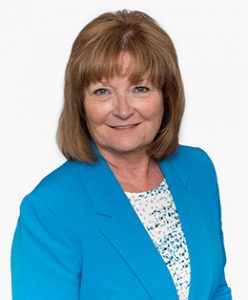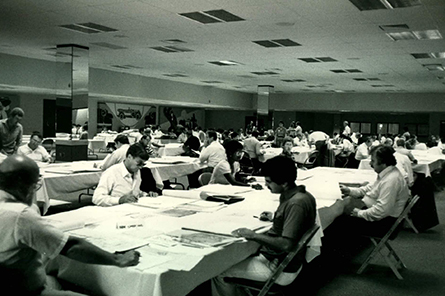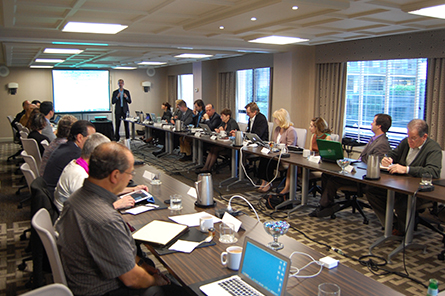Committees and Volunteers
Volunteers are the very foundation of NCARB. From its first meeting in 1919 to today, the majority of NCARB’s work is done by architects (and some non-architects) across the country volunteering their time and expertise to create standards that protect the public while enabling mobility.
VIDEO: Volunteering
From establishing the NCARB Certificate to creating the national exam, volunteers have been involved in all of the organization's major programs and initiatives. Learn more about the role volunteers have played in NCARB history over the past 100 years.

Evolution of Volunteers
NCARB has always been driven by the service of its volunteers. In early years, the Council’s priorities, ambitions, and successes could often be traced back to the vision of individuals whose experience and willpower drove the development of national standards.

“I think volunteering is the backbone of this organization, without the architect and executives that regulate the profession you wouldn’t have an organization.”
Gathering Volunteers
Prior to the 1960s, almost all the work was done by volunteer architects. Other than Emery Stanford Hall and his secretary, everyone who helped the organization get off the ground was a volunteer. As the Council worked through financial constraints, officers like President Emil Lorch refused reimbursement for things like travel expenses so that the Council could find it footing.
Their efforts were no small task. With several states having architect registration laws by 1920, and almost no two alike, the handful of volunteers had their work cut out for them:
“These officers were requested to take steps to bring all of the various state examining officials into a national organization to facilitate interchange of information, reciprocal registration, uniformity of license and registration laws; to discuss the merits of various examining methods, scope of examinations, and other matters of interest to the various committees, as well as for the purpose of improving the general educational standards of the architectural profession of the United States.”
At nearly every meeting, architects volunteered to research or lead efforts to develop recommendations or guidelines for the state boards. They organized meetings, gathered and compared licensing laws, wrote exam syllabuses, and experimented with experience programs—all while maintaining their practices at home.

As the Council grew, so did the number of people willing to give back to the profession in the form of time, insight, and expertise. Volunteers have led the research and development of every major program and initiative—establishing the NCARB Certificate in the 1930s; developing and maintaining a national examination in the 1950s and 1960s; getting a more formalized experience program off the ground in the 1970s; and figuring out how education could incorporate experience and examination to streamline getting licensed in the 2010s.
“I know of no other professional organization whose record of accomplishment is so directly attributable to the efforts of dedicated volunteers.”
Forming Committees
A lot of tasks were too big for just one person to work on, so committees arose early in NCARB’s history. With no official staff to rely on until the 1960s, committees filled the void. An Executive Committee, which we now call the Board of Directors, did most of the heavy lifting in the early years. However, they were not enough. Thankfully, other Annual Meeting attendees volunteered to help out.
The collaboration that happens on committees has become central to NCARB’s decision-making process. Committees were created to take the leaders’ ideas and turn them into functional, sustainable programs. Research committees gradually became permanent standing committees that helped keep pace with the needs of the jurisdictions.
Yearly committees emerged related to examination, experience, education, professional conduct, and policy. Over time, many of them have developed subcommittees as the breadth of information and needs related to their topics continued to grow. From time to time, special committees were created to focus on things like international relations and communications.

Volunteers and Committees Today
Today, more than 300 people volunteer on over 20 committees that work on NCARB initiatives each year. Together, they dedicate nearly 40,000 hours of service in a 12-month period to help the Council advance its programs. And while the majority are architects, NCARB’s volunteer pool includes a diverse range of individuals—from licensure candidates to educators, lawyers, and public representatives.
In the past decade in particular, NCARB has made an effort to make sure the next generation of architects has a voice in the regulation of the profession, adding positions for young professionals on existing committees and creating a Think Tank for licensure candidates and a Re-Think Tank for recently licensed architects.

NCARB’s current standing committees include:
- The Education Committee and Continuing Education Subcommittee, which oversee and evaluate NCARB’s education policies and continuing education initiatives.
- The Examination Committee and multiple ARE 5.0 subcommittees, which ensure the continued delivery of the ARE by creating new test items and assessing the existing exam and its policies.
- The Experience Committee and Experience Advisory Committee, which evaluate NCARB’s experience-related initiatives and provide insight into the development of the AXP.
- The Member Board Executives Committee, which offers input into NCARB’s services for licensing boards.
- The Policy Advisory Committee, which reviews proposed changes to NCARB’s programs and documents.
- The Professional Conduct Committee, which oversees any issues regarding the ethical standards of our customers.
- The Regional Leadership Committee, which focuses on regulatory issues specific to NCARB’s six geographical regions.
In addition, each year NCARB relies on multiple task forces to manage research, development, and recommendations regarding current issues, such as sustainability, model regulations, and preparing for the future.




